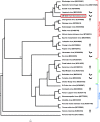Orbivirus RNA in a Banana Serotine (Afronycteris nanus) Bat in the Republic of the Congo
- PMID: 36629956
- PMCID: PMC9838363
- DOI: 10.1007/s10393-022-01619-2
Orbivirus RNA in a Banana Serotine (Afronycteris nanus) Bat in the Republic of the Congo
Abstract
Orbiviruses are arthropod borne viruses of vertebrates, with some of them being important pathogens of veterinary, conservation and economic importance, while others are occasionally associated with human disease. Some apparently bat specific orbiviruses have been detected, but little is known about their distribution and diversity. We thus sampled and screened 52 bats living in the Congo Basin, and detected RNA indicative of a novel orbivirus in a single banana serotine (Afronycteris nanus) by PCR. The detected RNA clusters with epizootic haemorrhagic disease virus, bluetongue virus, and others. The findings highlight the need for more studies into arbovirus presence and diversity in bat species.
Keywords: Africa; Orbivirus; bat; congo; diversity.
© 2023. EcoHealth Alliance.
Conflict of interest statement
None of the authors of this paper has a financial or personal relationship with other people or organizations that could inappropriately influence or bias the content of the paper.
Figures


References
-
- Attoui H, Maan S, Anthony SJ, Mertens PPC. Bluetongue virus, other orbiviruses and other reoviruses: their relationships and taxonomy. In: Mellor PS, Baylis M, Mertens PPC, editors. Bluetongue. London: Elsevier/Academic Press; 2009. pp. 23–52.
-
- Attoui H, Mendez-Lopez MR, Rao S, Hurtado-Alendes A, Lizaraso-Caparo F, Jaafar FM, Samuel AR, Belhouchet M, Pritchard LI, Melville L, Weir RP. Peruvian horse sickness virus and Yunnan orbivirus, isolated from vertebrates and mosquitoes in Peru and Australia. Virology. 2009;394:298–310. doi: 10.1016/j.virol.2009.08.032. - DOI - PubMed
-
- Bates PJ, Cameron K, Pearch MJ, Hayes B. A review of the bats (Chiroptera) of the Republic of Congo, including eight species new to the country. Acta Chiropterologica. 2013;15:313–340. doi: 10.3161/150811013X678955. - DOI
Publication types
MeSH terms
Substances
LinkOut - more resources
Full Text Sources

